Space travel is like a chalkboard in many ways. It is an ever-evolving medium that offers endless possibilities for exploration and discovery. It is a blank canvas to be filled with knowledge, and the boundaries of what we can learn are only limited by imagination.
Space travel provides us with the opportunity to explore the unknown, expand our horizons, and reach new heights. Just like a chalkboard, it is an exciting medium to ignite creativity and innovation. We can use it to craft ideas, develop theories, and push the boundaries of science and technology.
Space travel also allows us to see the universe from a different perspective. From Earth we can observe stars, galaxies, planets, and much more through telescopes and satellites. But from space we can experience these phenomena directly – giving us a better understanding of our place in the universe.Space travel offers numerous benefits compared to traditional chalkboard teaching methods. Firstly, the use of space-based resources and technology can provide a more immersive and stimulating learning environment for students. The use of virtual reality, 3D simulations, and robotics can help to engage students in a way that is not possible with chalkboards. Secondly, space travel can open up new possibilities for exploration and discovery. Students can experience a variety of physical environments which would be impossible in a classroom setting, such as the depths of the ocean or the surface of other planets.
Space travel also offers an opportunity to develop problem-solving skills outside of traditional classroom settings. Students can be presented with complex problems that require creative solutions that could not be accomplished with chalkboards alone. Finally, space travel also offers educational opportunities in areas such as astronomy, physics, and engineering that would not be possible with traditional teaching methods. Through these experiences, students will gain an appreciation for the complexities of space exploration and the importance of science in our daily lives.
Contents
- 1 A Historical Overview of Space Travel, Including the First Flights
- 2 The Evolution of Space Travel Technology
- 3 Cost Comparison of Space Exploration and Chalkboards
- 4 Different Types of Rockets Used For Space Exploration
- 5 Environmental Impact of Space Exploration Versus Writing on a Chalkboard
- 6 Conclusion
A Historical Overview of Space Travel, Including the First Flights
Space travel has been an area of fascination for humans since the dawn of time. From sky-gazing to rocket launches, we have sought to explore and understand the universe beyond our own planet. The first spaceflight was conducted by the Soviet Union in 1957, and since then space exploration has taken many forms. Spacecraft, satellites, and probes have been sent all over the solar system to explore, photograph, and bring back data about our celestial neighbors.
The first human spaceflight was conducted by Yuri Gagarin in 1961 on Vostok 1. His journey lasted 108 minutes and he became the first person to orbit Earth. After Gagarin’s historic flight, other countries began to launch their own missions into space. In 1962 American astronaut John Glenn flew aboard Friendship 7 on a five-hour mission around Earth. This was followed by other successful flights by American astronauts such as Neil Armstrong in 1969 who became the first person to walk on the moon during Apollo 11 mission.
Since then there have been countless other manned missions into space including Skylab (1973), Mir (1986), and International Space Station (1998). These missions have allowed us to gain a deeper understanding of our universe through observations from astronauts and cosmonauts in orbit around Earth or even further out in our solar system. As technology continues to improve so does our knowledge of what lies beyond Earth’s atmosphere.
Robotic probes have also become increasingly important for exploring outer space over time. In 1972 Pioneer 10 became the first spacecraft to leave our solar system while Voyager 1 and 2 sent back photos of Jupiter and Saturn before leaving the solar system in 1989. Additionally, Galileo (1989) provided us with unprecedented images of Jupiter’s moons while Cassini (1997) explored Saturn’s rings up close.
More recently there has been a surge of new private companies such as SpaceX that are looking to revolutionize space travel and exploration through more cost-effective methods than government-funded programs can provide. With these advancements we can only continue to expect exciting new discoveries about our universe as we look further out into the unknown depths of outer space.
The Evolution of Space Travel Technology
The world has come a long way since the first successful space mission in 1961. As technology advances, space travel and exploration has become more accessible, efficient, and economical. From the first rocket launch to the current International Space Station (ISS) orbiting Earth, space exploration has seen remarkable evolution in its technology.
Since then, rockets have become much better at achieving greater speeds and heights. The Saturn V rocket was one of the most powerful rockets ever developed and it was used to launch both Apollo 11 and 12 to the Moon. It also helped launch Skylab, America’s first space station. Today, modern rockets such as SpaceX’s Falcon 9 are capable of reaching higher altitudes and traveling at speeds up to 17,500 mph (28,000 km/h).
In addition to rockets, there have been several advancements in spacecraft designs that make them more efficient for longer missions. Early spacecrafts were basic capsules with minimal living accommodations for crew members. Nowadays, ISS astronauts live in a complex structure with many amenities such as exercise equipment, laboratories for scientific research, a kitchen for preparing meals and other luxuries.
Space exploration has also seen major improvements in communication technology. Early spacecrafts used radio signals that were limited by the speed of light; however modern-day craft use laser communications which can transfer data at up to 40 Gbps (gigabits per second). This allows astronauts to communicate with Mission Control much faster than before.
Finally, robotic probes have become increasingly important in exploring other planets. Early probes such as Voyager 1 and 2 were limited by their slow speed (about 10 km/s), but today’s probes such as Curiosity are able to reach speeds up to 65 km/s using advanced propulsion systems such as ion thrusters.
Overall, space travel has come a long way since its beginnings in 1961. With advances in rocket design and propulsion systems coupled with improvements in communication technology and robotic probes, space exploration is only getting better with time.
Technology Used in Space Travel vs. Chalkboard
Space travel has been a major development in the history of mankind, and with it comes a whole new set of technologies. While chalkboards have been used for centuries to teach and communicate ideas, space travel requires a completely different set of technologies.
For starters, space travel utilizes technology such as satellites, rockets, and spacecrafts that allow for communication between Earth and space as well as transportation from one place to another. These technologies are much more advanced than anything seen on a chalkboard. For example, satellites are able to send messages back and forth from Earth to space using radio waves or microwaves, while rockets use propulsion systems to leave Earth’s atmosphere and reach outer space. Additionally, spacecrafts are designed to withstand the intense conditions found in outer space and can be used for exploration or transport of people or materials.
In terms of communication, chalkboards simply cannot compare to the technology used in space travel. Spacecrafts are equipped with sophisticated communication systems that allow astronauts to communicate with mission control back on Earth while they are in outer space. This is done through the use of radio waves or microwaves which can be transmitted over long distances without interference or disruption. Additionally, spacecrafts also utilize computers and specialised software which allow astronauts to perform calculations or store data while they are away from Earth.
Overall, the technology used in space travel is significantly more advanced than anything seen on a chalkboard. From communication systems to propulsion systems and specialized software, the technology used in space travel enables us to explore unknown parts of our universe with greater confidence and accuracy than ever before.
Practical Uses of Space Travel
Space travel has the potential to provide us with a multitude of practical benefits. From advancing scientific research to providing new energy sources, space exploration is an incredibly important endeavor that can greatly improve our lives on Earth. It can help us understand the universe around us, develop sustainable living solutions, and potentially even find new planets that could sustain human life.
Space travel also has a variety of other practical applications. For example, it can be used to create new medicines and treatments for illnesses, as well as to explore and develop new sources of energy. Additionally, it can be used to monitor the environment and climate change on Earth and offer insight into how we can better protect our planet.
Versus a Chalkboard
While chalkboards are still widely used in many classrooms today, space travel offers more potential for practical applications than chalkboards could ever reach. For example, space travel allows us to conduct experiments in a zero gravity environment, something that cannot be done with a chalkboard. Additionally, space exploration provides us with an opportunity to observe the universe in ways that are not possible through traditional means such as a chalkboard. Finally, it allows us to discover things that would have been impossible to determine from the ground – such as how stars form or how different planets interact with each other – thus offering insight into how our universe works.

Cost Comparison of Space Exploration and Chalkboards
The cost comparison between space exploration and chalkboards is an interesting topic to explore. Space exploration is a costly endeavor, with the costs of a single mission typically running into the billions of dollars. On the other hand, chalkboards are relatively inexpensive, with a decent-quality chalkboard costing only a few hundred dollars.
In terms of long-term costs, space exploration can be expensive due to launch costs and other associated expenses. However, once a mission has been completed it will usually be much cheaper to maintain than if it had to be continued indefinitely. Chalkboards can also be expensive in the long term due to regular maintenance requirements such as refilling supplies and cleaning.
In terms of upfront costs, space exploration is significantly more expensive than chalkboards. A single mission can cost billions of dollars and requires huge amounts of planning and preparation before launch. In contrast, a good-quality chalkboard may only cost a few hundred dollars and can be used almost immediately after purchase.
Space exploration typically requires large teams of highly trained professionals to plan and execute missions, which further drives up the cost. Chalkboards on the other hand generally require minimal personnel for setup or maintenance, making them much more affordable in terms of labor costs.
Overall, while both space exploration and chalkboards have their advantages and disadvantages in terms of cost comparison, it is clear that space exploration is significantly more expensive upfront while chalkboards may require more ongoing maintenance over time.
Different Types of Rockets Used For Space Exploration
Rockets have been used for centuries to explore space, with different types of rockets employed for various purposes. The most commonly used rocket engines are liquid-propellant and solid-propellant types. Liquid-propellant rockets provide a powerful thrust for launching spacecraft into orbit and can be used to reach other planets and distant stars. Solid-propellant rockets are simpler and more reliable than liquid-propellant engines, but they do not provide enough power to reach other planets.
The most powerful of all the rockets used in space exploration is the Saturn V, which was used by NASA in the Apollo missions. This massive rocket was composed of three stages, each powered by its own set of five F-1 engines burning liquid oxygen and kerosene as propellants. The Saturn V delivered enough thrust to propel the Apollo spacecraft into Earth orbit, as well as to send it on its way to the Moon.
Another type of rocket engine is the air-breathing rocket engine, which uses atmospheric oxygen instead of adding its own oxygen source. This type of engine has been tested on several occasions but is still in the experimental stage. If perfected, it could be used to launch spacecraft from Earth’s surface directly into orbit without requiring any additional stages or propellants, making launches much more efficient and cost effective.
Chemical propulsion systems are also widely used in space exploration. Chemical propulsion systems use chemical reactions between fuel and oxidizer to generate thrust for a spacecraft or satellite. The most commonly used chemicals are hydrazine and nitrogen tetroxide, which produce high levels of thrust when combined with a fuel such as kerosene or liquid hydrogen.
Electric propulsion systems are another type of rocket engine that can be used for space exploration. Electric propulsion systems use electric fields instead of chemical reactions to generate thrust, allowing them to achieve higher efficiency rates than chemical engines but at lower levels of thrust per unit volume (Isp). Electric propulsion systems are often used on satellites and other deep space probes due to their ability to generate long duration thrusts over extended periods of time with minimal fuel consumption.
Finally, nuclear thermal propulsion (NTP) has been proposed as a potential means for powering deep space exploration missions in the future. NTP uses a nuclear reactor core as a heat source for driving an expelled gas through a nozzle at high velocities, producing greater amounts of thrust than chemical engines but with higher efficiency rates than electric propulsion systems (specific impulse). NTP technology is still in its early stages but has been proposed for future missions such Mars sample return or human mission flights beyond Earth’s orbit.
Overall, there are many different types of rockets that have been developed over the years for use in exploring our universe from Earth’s surface out into the vastness beyond; each type has its own unique advantages and disadvantages depending on mission requirements.
Environmental Impact of Space Exploration Versus Writing on a Chalkboard
Space exploration and writing on a chalkboard are two very different activities, but they do have one thing in common: their environmental impact. While space exploration requires expensive resources and has a much larger environmental footprint than writing on a chalkboard, both activities can have serious effects on the environment.
Space exploration requires large amounts of energy and resources to propel rockets into space and maintain satellites in orbit. The fuel used for these missions is often highly toxic, creating air pollution that can have severe health impacts. Additionally, many space missions involve launching satellites that produce hazardous waste, including radioactive materials and solid debris. This debris can cause damage to other spacecrafts, as well as create an increase in atmospheric radiation levels.
Writing on a chalkboard also has an environmental impact. A typical chalkboard is made from materials like wood or plastic that require energy to manufacture and transport. The dust produced by erasing the board can contain hazardous particles like silica or crystalline quartz that can be inhaled, leading to respiratory problems. In addition, the erasers used to clean the board contain small amounts of rubber which can release harmful chemicals into the air when heated from friction during use.
The environmental impacts of both space exploration and writing on a chalkboard are significant but vary greatly in scope and severity. While space exploration involves costly resources with long-term effects, writing on a chalkboard has more immediate impacts due to its smaller scale. It’s important for individuals to consider both activities when evaluating their personal environmental impact.

Conclusion
Space travel is quite like a chalkboard in many ways. From the physical characteristics to the practical applications, both have much in common. Space travel allows us to explore the unknowns of our universe, just like a chalkboard lets us explore our thoughts. There is no limit to what can be achieved with either of them, and both are tools that can be used for creative and innovative purposes. Space travel has allowed us to reach further and further into the depths of space, allowing us to uncover new information and possibilities that were never before known. Similarly, a chalkboard allows us to express ourselves in unique and creative ways, such as by drawing or writing on it. In conclusion, space travel and a chalkboard are both tools that can be used for exploration and creativity in their respective fields.
Both have proven their worth over time, but only time will tell what new possibilities each will bring in the future.





